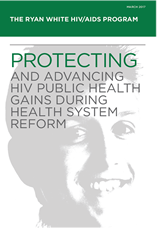
On March 24, 2017, Jeffrey S. Crowley and Sean Bland of the O’Neill Institute for National and Global Health Law and Connie Garner of Foley Hoag LLP released a new report, “The Ryan White HIV/AIDS Program: Protecting and Advancing HIV Public Health Gains During Health System Reform.” Although the HIV no longer dominates headlines as it once did, it continues to affect many people within the United States. The Ryan White HIV/AIDS Program is an integral part of ensuring that Americans living with HIV have access to treatment and the support they need. Given the current uncertainty about the future direction of the United States (US) health system, effective continuation of the Ryan White Program is critical to ensuring we maintain all the progress made against the HIV epidemic thus far.
How does the Ryan White HIV/AIDS Program work?
The Ryan White HIV/AIDS Program is a federal program that provides medical care, prescription drugs, and support services to more than a half a million uninsured and underinsured people living with HIV/AIDS in the US. Although most Ryan White clients (80% in 2015) have some form of insurance coverage, the Ryan White Program affords them access to critical and important services that are not covered by their insurance. The program provides models for integrated care that brings together physical and mental health services. It also provides mechanisms to monitor health outcomes and ensures capacity to provide HIV medical care across the country through both technical assistance and funding.
The Ryan White Program operates as a safety net to ensure patients with HIV get access to the medical care and services they need in a cost effective and coordinated manner.
What has the Ryan White HIV/AIDS Program done?
The Ryan White HIV/AIDS Program began in 1990 and was initially an emergency response to the growing HIV epidemic in the US. Since its inception, the Ryan White Program has continued to receive bipartisan support and has been reauthorized by Congress four times. With each reauthorisation, the program has evolved to better respond to the changing HIV epidemic. Although the Program’s authorization has now lapsed, it has continued functioning under its prior authority and has been funded through annual Congressional appropriations. Since the last reauthorization in 2009, there have been meaningful scientific developments. The Affordable Care Act has also expanded insurance coverage to many people with HIV, which has prompted many states to shift the focus of their programs to focus on other issues, including mental health and substance abuse treatment as well as cost-sharing assistance. The role of the Ryan White Program will likely become even more critical as the health system changes.
The Ryan White Program has led to tangible improvements in health outcomes including increasing rates of viral suppression and reducing health disparities. These outcomes have the further benefit of reducing new HIV infections. This is because when people with HIV are virally suppressed – i.e. the amount of HIV virus within their blood is undetectable – they do not transmit the disease to other people. In fact, The Partners of People on ART–A New Evaluation of the Risks (PARTNER) Study, a European observational study of serodiscordant partners (one partner was HIV positive and one was HIV negative), recently found that no transmissions resulted from virally suppressed individuals.
Preventing HIV infections also results in reducing health care costs. The estimated medical cost saved by avoiding one HIV infection is $229,800. In 2014, there were 8,500 fewer HIV infections than in 2008. That difference in annual infections alone will result in $2 billion in less national health care spending. If these trends of fewer infections continue, the savings to the nation will grow exponentially. However, these costs are only avoided if people living with HIV continue to achieve viral suppression.
Given evidence regarding the importance of viral suppression in prevention efforts, consideration should be given to how the Ryan White Program could increase population-level HIV viral suppression by leveraging program data to address populations and communities with the most urgent needs. Promoting and expanding access to pre-exposure prophylaxis (PrEP) for HIV prevention is another potential role the Ryan White Program could fulfill in the future. Policy makers could also consider whether there could be a role for the Ryan White Program to be expanded to address other health issues such as Hepatitis C.



